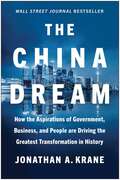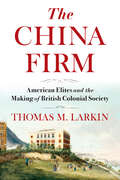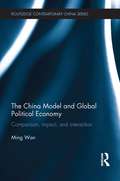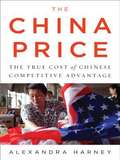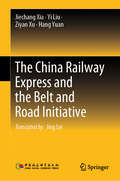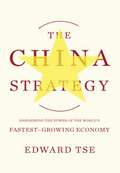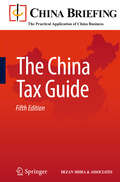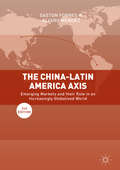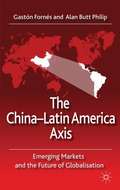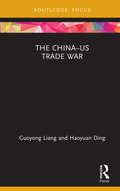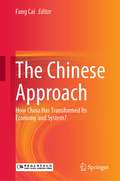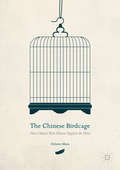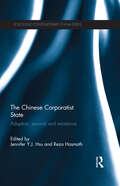- Table View
- List View
The China Dream: How the Aspirations of Government, Business, and People are Driving the Greatest Transformation in History
by Jonathan A. KraneWALL STREET JOURNAL BESTSELLER &“An American corporate executive&’s paean to 21st-century China—and a call for doing business there.&” —Kirkus Reviews Many people do not have a full understanding of China today, yet it has created the greatest economic transformation in history. Since the early 1990s, hundreds of millions of people have moved to cities in China, where they gain access to better schools, health care, and infrastructure, as well as higher-paying jobs. China&’s GDP has grown from $300 per capita to more than $10,000 in the past 30 years and lifted more people into the middle class than in any other country at any other point in human history. It is important for investors, US companies, and anyone interested in the global economy to understand China. China is rapidly shifting from an export-driven, low-cost manufacturer to a consumer-driven economy, and the wealth of China&’s 1.4 billion consumers continues to grow. As the founder and CEO of KraneShares, an asset management company focused on China and headquartered in New York, author Jonathan A. Krane provides an inside look at China&’s transformation into a global superpower and explains why the relationship between the US and China is the most critical economic relationship in the world today. The China Dream is your guide to understanding China&’s unmatched economic growth and fully realizing its status as an essential element in any well-designed investment portfolio, global business, and participation in the global economy.
The China Dream: The Quest for the Last Great Untapped Market on Earth
by Joe Studwell“An entertaining, if cautionary, tale of Western business woes in China, stretching back seven hundred years” (The Wall Street Journal). In The China Dream, acclaimed business journalist Joe Studwell challenges the predictions that China will become an economic juggernaut on the world stage in the twenty-first century—and instead foresees an economic crisis. Tracing the most recent developments in China from Deng Xiaoping’s “liberalization” of its market in the 1980s through the opening of its economy to foreign investment in the 1990s, Studwell examines the roadblocks to the continuation of the country’s unprecedented expansion and why its economy will fail once more—but this time, harder than ever before, and with potentially catastrophic results. Provocative and flawlessly researched, The China Dream analyzes what’s really going on in China—and what we can do to prepare for the coming crisis. “The much-needed antidote to the delusions . . . about the riches to be made from investing and selling in China. Brimming with . . . statistics.” —The Washington Post “[A] detailed account . . . An excellent examination of the political and economic history of China, fascinating and mostly unknown to Westerners.” —Booklist (starred review) “Lays bare much of the stuff and nonsense that surrounds the China dream, and traces how myth and misunderstandings—compounded by hype and lashings of snake oil—have bewitched some of the world’s most respected corporations and led them to ruin the proverbial $1.3 billion consumer market . . . As such, it deserves to help redefine the debate on the nature of the China market.” —James Kynge, China bureau chief of the Financial Times
The China Factor: Leveraging Emerging Business Strategies to Compete, Grow, and Win in the New Global Economy
by Ken Wilcox Amy KaramThe Innovation of Globalization - proven strategies to out-win disruptive global competition. Does your company know how to compete in the evolving global business arena with emerging entrants? What tactics must your company use to overcome price discounting wars that cut into your margins? What are the success factors your new rivals incorporate that may prove more valuable to customers than the superior products you offer? The China Factor equips Western businesses with a practical framework for competing successfully in today's ever-changing global markets. Written by a 20-year expert in competitive strategy and global market expansion, this book is packed with insights gained through first-hand experience leading competitive programs at a high-tech multinational corporation and customers across 50 countries Karam has worked with companies like Cisco, Apple, CapitalOne, as well as start-ups, and is a corporate instructor of Stanford courses, as well as her own. When it comes to globalization, the rules have changed--what was once nice-to-know is now need-to-know, and this book lays it out in a clear, no-nonsense style. Based on customers in over 50 countries, you will learn why a premium product, though domestically successful, may not be well received in foreign markets, and you'll discover the critical factors that contribute to success in both established and emerging markets. Disruptive competitors are transformed from threats to examples as you learn to recognize opportunities for re-evaluation, and shift your strategy to stay ahead of the curve. The economic rise of China and other new entrants is challenging Western companies in new ways. This book explains why, and provides actionable strategies for success in any market. Grow and maintain a strategic Innovation Advantage Understand the power of politics in business Develop a deeper Culture IQ to expand your customer base and win Implement market-specific sales tactics to succeed in emerging markets Learn from disruptors how to win your target customers Discover how the convergence of East & West is evolving innovation models You're already well-aware of the global threat to Western business, and endless analysis only goes so far toward a solution. You need to know how to respond, survive, and thrive, and just how to regain the competitive edge. The truth is that Western companies must change they way they do business, and push innovation beyond the product and into every aspect of every operation - they need to be innovative in how they do business abroad. The China Factor provides a clear action plan, and case studies from global leaders like Cisco, Xiaomi, and Apple with insightful strategies for changing and winning the game. The foreword, written by Ken Wilcox, Chairman Emeritus, Silicon Valley Bank and founder of the joint banking venture with Shanghai Pudong Development Bank Co. Ltd. "The China Factor is right on the mark. It addresses a real need, one that no one else is tackling - the action that US and other Western-based companies can take in response to the China challenge. Global competitiveness is a huge problem for the West and companies are ill-prepared. This book goes beyond what others do, providing an important, insightful and practical prescription on how they can shift their strategy and be more successful when competing in, and with, emerging countries."
The China Fantasy: How Our Leaders Explain Away Chinese Repression
by James MannWhat are our ideas and hidden assumptions about China? Does America's policy toward China make sense? In this vigorous look at China's political evolution and direction, Mann offers a startling vision of our future with China that will have a profound impact for decades to come.
The China Firm: American Elites and the Making of British Colonial Society (A Nancy Bernkopf Tucker and Warren I. Cohen Book on American–East Asian Relations)
by Thomas LarkinWhat roles did Americans play in the expanding global empires of the nineteenth century? Thomas M. Larkin examines the Hong Kong–based Augustine Heard & Company, the most prominent American trading firm in treaty-port China, to explore the ways American elites at once made and were made by British colonial society. Following the Heard brothers throughout their firm’s rise and decline, The China Firm reveals how nineteenth-century China’s American elite adapted to colonial culture, helped entrench social and racial hierarchies, and exploited the British imperial project for their own profit as they became increasingly invested in its political affairs and commercial networks.Through the central narrative of Augustine Heard & Co., Larkin disentangles the ties that bound the United States to China and the British Empire in the nineteenth century. Drawing on a vast range of archival material from Hong Kong, China, Boston, and London, he weaves the local and the global together to trace how Americans gained acceptance into and contributed to the making of colonial societies and world-spanning empires. Uncovering the transimperial lives of these American traders and the complex ways extraimperial communities interacted with British colonialism, The China Firm makes a vital contribution to global histories of nineteenth-century Asia and provides an alternative narrative of British empire.
The China Information Technology Handbook
by Miltiadis D. Lytras Patricia Ordóñez de PablosThis handbook is a reference for those interested in information technologies and emerging management practices in China. The emphasis on information technologies and management provides a unique proposition and gives characteristics of flexibility and adoption to diverse audiences. The subject area is a combination of global information technology and management along with strategic management of IT. The handbook exploits state-of-the-art and emerging trends in theory and technology. This handbook is primarily designed for a professional and academic audience.
The China Model and Global Political Economy: Comparison, Impact, and Interaction
by Ming WanSince the beginning of China's phenomenal rise in the international system, our knowledge of the country has grown rapidly. But those who have debated the China issue in policy circles mostly focus on the implications of China’s rise, often without a firm understanding of why the country is rising in the first place. Using an analytical framework which links China’s domestic political economy order and the global system, this book helps us to understand China’s rise and the China model more clearly. Indeed, unlike most other works that study the China model as a domestic political economy issue, it adopts an explicit international comparative perspective, comparing the Chinese model to others, such as the Washington Consensus and the Japan model. This comparison allows us to break down different components of the China model, and to show that while the Chinese Communist Party leadership part of the model is unique, other components such as export-led growth strategy or packaged aid programs are not. By focusing on the root cause of China's rise - namely the loop between the evolving China model and an evolving global governance structure – this book reveals the degree of compatibility between the country’s profit-driven domestic political economy system and the post-war global economic order, and in turn how and why China has been able to rise in the global system. The China Model and Global Political Economy makes a key contribution to theories of international relations, state development and modernization, and as such will appeal to students and scholars of Chinese politics, Chinese foreign policy, international political economy, development studies and international relations.
The China Path to Economic Transition and Development
by Yinxing HongThis book by the renowned Chinese scholar Dr. Yinxing Hong provides the reader with a perceptive analysis of what has worked in China's development model. Over the past 30 years, China has experienced a remarkable economic rise, but it now faces the challenge of switching the drivers of this economic growth, which have proven so successful. The path has not been an easy one, and many challenges lie ahead. However, the rise of the Chinese economy has been the most significant global development in recent years. Is there a specific Chinese model? How was the Chinese transition, from a Soviet-style economic structure to one that is more open to market influences and the global market, achieved? In 15 essays, Dr. Hong provides fascinating insights to these and other key questions. The essays cover the challenges involved in transition and how the market-oriented reforms progressed; what the consequences of the transition were for public goods provision and how China opened up its economic system. The essays in Part II address the remaining challenges facing rural areas trying to develop a more consumer-driven economic base, and how to effectively modify the model of economic development. This book provides a sound basis for policymakers and scholars alike, as well as anyone who wants to get an insider's view of the progress and challenges faced by China's economic development.
The China Price
by Alexandra HarneyIn this landmark work of investigative reporting, former Financial Times correspondent Alexandra Harney uncovers a story of immense significance to us all: how China's factory economy gains a competitive edge by selling out its workers, environment, and future. Harney's firsthand reporting brings us face-to-face with a world in which intense pricing pressure from Western companies combines with ubiquitous corruption and a lack of transparency to exact a staggering toll in human misery and environmental damage. This eye-opening expose offers, for the first time, an intimate look at the defining business story of our time. .
The China Question: Contestations and Adaptations
by Nicole Talmacs Dragan PavlićevićThe China Question: Contestations and Adaptations provides fresh perspectives on, and empirics about, China’s international relations through the lens of the local and regional configurations and developments around the world. While China’s foreign policy strategies have received much attention, and in particular the Belt and Road Initiative (BRI), the local contestations and/or adaptations that China provokes in the countries and regions it engages remain under-researched. In this book, a global collection of scholars examines how countries, societies, and individuals around the world are responding to China‘s rise.
The China Question: Toward Left Perspectives
by Eli Friedman, Kevin Lin, Ashley SmithIs there a &“Left perspective&” on the US-China rivalry? The US-China conflict is no straightforward Great Power rivalry. Understanding it requires wrestling with its multiple dimensions and consequences, from geopolitics to economic interdependence, anti-Asian racism in the US and organizing amongst immigrant diasporas, social movements in China and the character of Chinese capitalism. This ebook groups together insights and perspectives that provide a critical analysis of Chinese capitalism and the movements it produces. In so doing, it provides the basis for developing a progressive, left position on American empire, China&’s ascent, and the conflict between the two.Contributors include activists and intellectuals committed to opposing capitalism and class society, racialized and gendered forms of domination, and the imperialist structure of the interstate system: Rebecca Karl, David Harvey, Ho-Fung Hung, Yige Dong, Eli Friedman, Kevin Lin, Ashley Smith, Dennis Kosuth, Abdullah Younus, Jake Werner, Tobita Chow, Cuizi Liu, Matt Huber, JS Chen, David Grophy, Wilfred Chan, Brian Hioe, and Zifeng Liu.
The China Railway Express and the Belt and Road Initiative
by Yi Liu Jiechang Xia Hang Yuan Ziyan XuThis book presents an overview of the development of China-Europe express train in the broader context of BRI. It analyzes the benefits to the regions along the route from the safe, smooth and stable operation of the train in recent years, involving the strong impetus for building a new pattern of dual cycle development and driving the recovery of the economy in the post-pandemic era. Based on in-depth case studies of the operations in many regions, this book proposes measures in order to promote the high-quality development of China-Europe train: to improve infrastructure and enhance port capacity; to unify international standards and improve the efficiency of train customs clearance; to open up the European market and actively organize the return source of goods; to standardize government administrative intervention according to market orientation; to strengthen the construction of digital infrastructure with the focus on connectivity; to cultivate international logistics talentsand build a high-quality China-Europe express train talent team.
The China Strategy: Harnessing the Power of the World's Fastest-Growing Economy
by Edward TseNo major enterprise or financial institution can avoid doing business with China--if not directly, then through myriad hidden connections. Global businesses either use Chinese resources or sell to and in China or compete with companies that do. <P><P> Because there's no avoiding China, business leaders need a framework that orders the different (and seemingly contradictory) streams of data that hint at its future. That framework is The China Strategy. In this invaluable book, Edward Tse explains the ever-changing nature of China's business environment, its increasingly complex relationship with the rest of the world, and the global business implications--not just for our current environment but for the next decade. Change, Tse argues, is taking place in non-linearly. Some dimensions (like Chinese entrepreneurship) are expanding exponentially, while others (like the value of China's labor arbitrage) may be reaching a plateau. Eschewing easy explanations, Tse shows how to build and execute a global business strategy in light of these changes, offering practical advice amidst a sea of simple books that offer too-quick solutions. In a world in which a successful business strategy means a successful China strategy, this book is uniquely positioned to help business leaders navigate the "country that cannot be ignored. "
The China Tax Guide
by Andy Scott Sam Woollard Chris Devonshire-EllisThis guide is a practical overview for the international businessman to understand the rules, regulations and management issues regarding taxes in China. It is written very much from practical experience. We will help you to understand the implications of what can initially appear be a complicated and contradictory subject. This book tells you the basics of what you need to know, and point you at the structures you should use to enable your China business to be both in compliance and as tax efficient as possible.
The China-Latin America Axis: Emerging Markets And The Future Of Globalisation
by Gaston Fornes Alvaro MendezThis second edition explores and accounts for the many changes in the emerging markets of China and the Latin American countries since 2011. Taking account of major developments such as the rapid expansion of the Chinese state and the on-going effects of the global recession, the authors present current case studies and data on both Chinese and Latin American companies, including updates on those included in the first edition and the presentation of new innovative start-ups. Including an international relations perspective alongside business strategy and global markets, The China-Latin America Axis second edition presents the drastic changes in the globalized economy in the past five years.
The China-Pakistan Economic Corridor of the Belt and Road Initiative: Concept, Context and Assessment (Contemporary South Asian Studies)
by Siegfried O. WolfThis book focuses on the implementation of the China-Pakistan Economic Corridor (CPEC), a multi-billion-dollar infrastructure development project intended to connect Asia with Europe, the Middle East and Africa. By introducing a new analytical approach to the study of economic corridors, it gauges the anticipated economic and geopolitical impacts on the region and discusses whether the CPEC will serve as a pioneer project for future regional cooperation between and integration of sub-national regions such as Balochistan, Khyber Pakhtunkhwa, the Federally Administered Tribal Areas, and Gilgit-Baltistan. Further, it explores the interests, expectations and policy approaches of both Chinese and Pakistani local and central governments with regard to the CPEC’s implementation. Given its scope, the book will appeal to regional and spatial sciences scholars, as well as social scientists interested in the regional impacts of economic corridors. It also offers valuable information for policymakers in countries participating in the Belt-and-Road Initiative or other Chinese-supported development projects.
The China-US Trade War and South Asian Economies (Routledge Frontiers of Political Economy)
by Rahul Nath ChoudhuryThe USA and China, the world’s largest economic powers, have been engaging in trade war since January 2018. The impact of this trade war is felt not only by US and China but also by other economies who have economic ties with them. This book provides insights into damages caused by this trade war. The first section of the book looks at the impact of the trade war on the global economy. It goes deeper to examine the trade war impact on the South Asian region. It is well-known that any imposition of new tariffs or an increase in existing tariffs would make imports more costly and render the exported goods less competitive. Yet, the book posits that the trade war has provided a window of opportunity to other countries not caught in it. The South Asian region, with countries like Bangladesh, India and Sri Lanka, has actually reaped benefits from the widening trade dispute between the world’s two biggest economies. This book will be a useful reference to help policymakers to undertake informed decisions and initiate programs to minimise the trade war impact.
The China–Latin America Axis
by Gastón Fornés Alan Butt PhilipThe impressive growth of trade and investments between China and Latin America has attracted the attention of the business world and policy makers. This book analyses the business of the main players atthe country/region and company levels in the context of globalization and growing importance of emerging markets in the world economy.
The China–US Trade War (Routledge Focus on Economics and Finance)
by Guoyong Liang Haoyuan DingAn unprecedented trade war broke out between the world’s two largest economies in 2018 and escalated subsequently. It is the first major economic conflict happened in the era of globalization, with its aftermath going far beyond trade. The trade war weighs heavily on China and the United States and threatens the world economy and the global trading system. This book provides a timely account of the US-China trade war with insights into its causes and consequences. Examining through the lenses of both history and theory, it analyses the context and causes of the trade war, the intertwined processes of tariff combat and trade negotiations, and the impacts on international trade, foreign direct investment, macroeconomic performance and firm behaviour. It also addresses the long-term strategic and geopolitical implications of the ongoing trade and economic confrontation. The book will appeal to those interested in international economics and politics, global governance and development.
The Chinese
by Jasper BeckerThis is the hidden story of people of the world's largest nation--so poorly understood and so vital to the future. It exposes the Chinese society in all of its layers: from remote, illiterate peasants; to the rising classes of businessmen.
The Chinese Approach: How China Has Transformed Its Economy and System?
by Fang CaiThis volume introduces readers to the achievements made in the context of China’s reform and opening up. It tells China’s story with regard to twelve aspects: the reform path, opening up, macro-economy, regional development, the “three rural” policy, poverty alleviation, industrial development, scientific and technological leadership, ecological civilization, human resources, social security, and income distribution. On the one hand, China’s successes and lessons learned in this regard – e.g. the establishment of special economic zones and pilot zones in advance, followed by the implementation of regional development strategies – can be condensed into a general sense of Chinese wisdom. On the other, China’s participation in economic globalization and global economic governance can serve as a role model, helping developing countries overcome poverty and move towards modernization. As China accounts for nearly one fifth of the world’s total population, the problems and difficulties that it faced at the beginning of reform and opening up are similar to those of many developing countries; therefore, it can provide valuable guidance for developing countries in the form of Chinese wisdom and Chinese approach.
The Chinese Banking Industry: Lessons from History for Today's Challenges (Routledge Studies on the Chinese Economy #Vol. 26)
by Yuanyuan PengThis book provides detailed systematic micro-level analysis of the historical development of the Chinese banking industry, focusing in particular on the development of the Bank of China (BOC) in the period 1905 to 1949. Banking reform is a key area of China’s economic transformation, and this book, bringing a vast amount of material to a Western audience for the first time, provides a detailed evidence of the key challenges faced by a major Chinese bank. The book: addresses important issues in its evolution, including corporate governance government intervention, foreign competition and white-collar crime evaluates how the challenges in these areas were met considers the results of its efforts draws lessons for policy making today.
The Chinese Birdcage
by Heleen MeesThis book vividly describes how China's rise in the early 2000s led to rising profits and declining labor income everywhere, ultimately resulting in the global financial crisis. Under Deng Xiaoping's policy of 'reform and opening up' in the 1980s, China quickly became the world's factory floor. . . but powerful political leaders envisioned a world in which the market economy would be trapped within the confines of a planned economy. With China's admission into the World Trade Organization in 2001, almost a billion people joined the global workforce, driving down the real wages of blue- and white-collar workers in the US and Europe while also lowering interest rates, which fueled housing bubbles and destabilized the financial sector. This book explores China's significant influence on western economies by focusing on the links between the labor market, corporate profits, and interest rates, using Arthur Lewis's framework for economic growth with unlimited supplies of labor to argue that by 2010 the world economy - and political situations - had been set back almost one hundred years.
The Chinese Corporate Ecosystem
by Colin S. HawesChallenging simplistic claims that Chinese corporations merely serve Communist Party goals, this book argues we cannot understand these corporations without tracing their dynamic evolution within a unique socio-political ecosystem. Vivid case studies illuminate the strange hybrid structures and networks that are essential for corporate success in the Chinese habitat. Tracing the reciprocal impacts between Chinese corporations and their environment, Colin S. C. Hawes reveals how corporations' political adaptations have raised serious obstacles for their international expansion and worsened China's environmental crisis. Adopting an interdisciplinary approach that synthesizes insights from behavioural economics, science and Chinese philosophy, this book proposes innovative solutions to the damaging impacts of Chinese corporations. It makes a compelling case for redirecting the vital energy of corporations and government officials in more productive and sustainable directions.
The Chinese Corporatist State: Adaption, Survival and Resistance (Routledge Contemporary China Series)
by Reza Hasmath Jennifer Y. J. HsuThe modern Chinese state has traditionally affected every major aspect of domestic society. With the growing liberalization of the economy, coupled with increasingly complex social issues, there is a belief that the state is retreating from an array of social problems from health to the environment. Yet, a survey of China’s contemporary political landscape today reveals not only a central state which plays an active role in managing social problems, but also new state actors at the local level which are increasingly seeking to partner with various non-governmental organizations or social associations. This book looks at how NGOs, social organizations, business associations, trade unions, and religious associations interact with the state, and explores how social actors have negotiated the influence of the state at both national and local levels. It further examines how a corporatist understanding of state-society relations can be reformulated, as old and new social stakeholders play a greater role in managing contemporary social issues. The book goes on to chart the differences in how the state behaves locally and centrally, and finally discusses the future direction of the corporatist state. Drawing on a range of sources from recent fieldwork and the latest data, this timely collection will appeal to students and scholars working in the fields of Chinese politics, Chinese economics and Chinese society.
